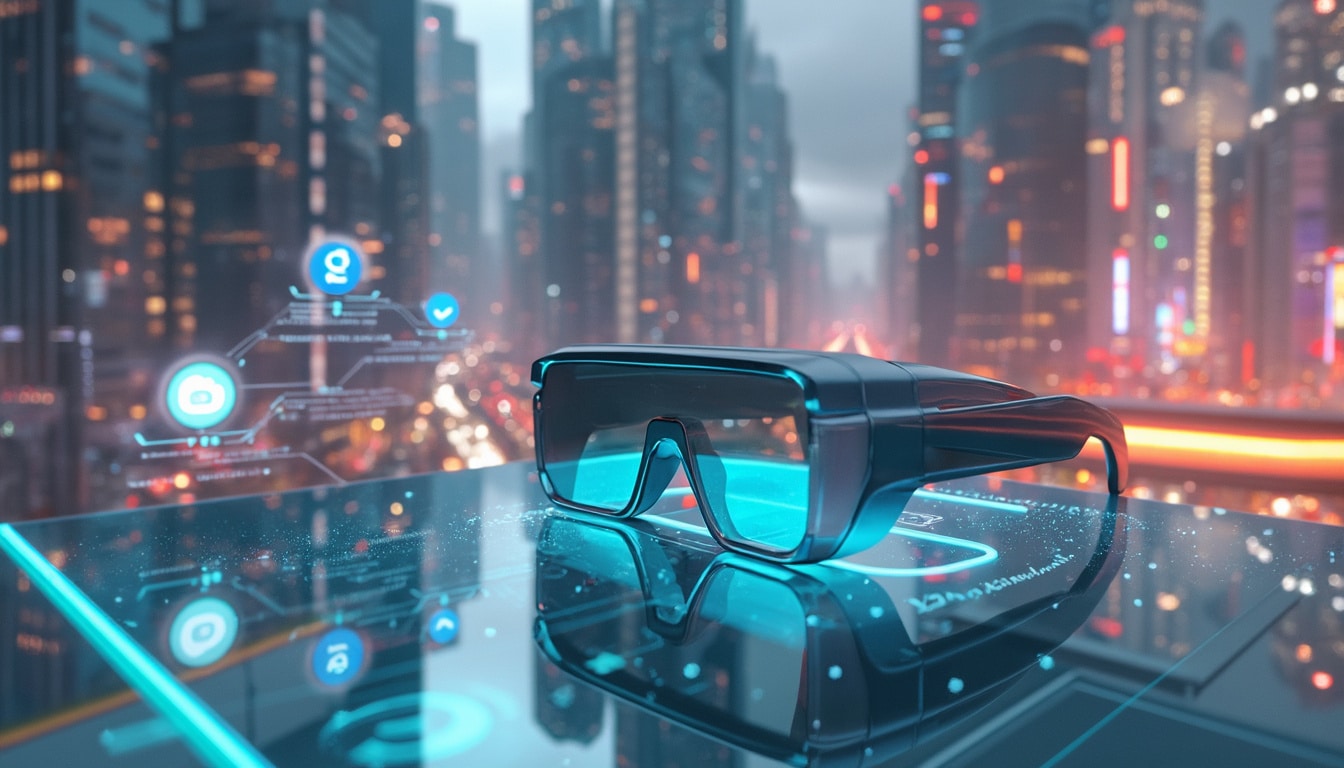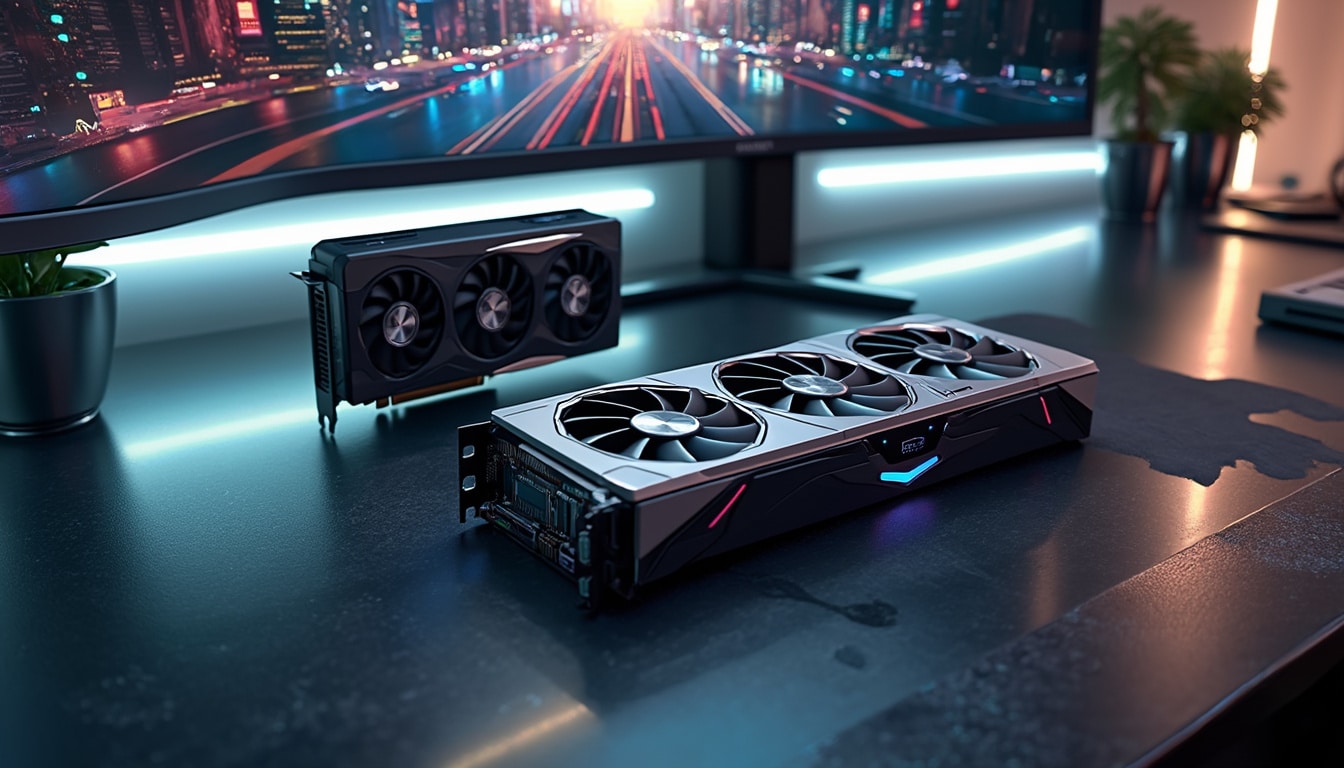« `html
Hold onto your hats, tech enthusiasts! Google just took a giant leap into the future. At TED2025, they unveiled something that might just change the way we see the world.
Imagine strapping on a pair of glasses that not only correct your vision but also supercharge it with cutting-edge technology. Google’s new Android XR smart glasses were showcased live, revealing a host of features that blend seamlessly into our daily lives. From displaying your favorite apps to understanding what you’re looking at, these glasses are more than just a stylish accessory. Integrated with Gemini, Google’s in-house AI, they respond naturally in multiple languages, opening up a world of possibilities. Whether you’re translating a sign in real-time or asking for a haiku while browsing your bookshelf, these glasses handle it all with flair. Plus, they’re compatible with prescription lenses, ensuring that everyone can experience this technological marvel without compromise. Connected to your smartphone, they offer the convenience of accessing all your apps right before your eyes, making presentations and translations effortlessly smooth.

Table of contents
ToggleIntroducing Google’s Android XR glasses: A glimpse into the future
At the recent TED2025 conference in Vancouver, Google took the tech world by storm with the live unveiling of their groundbreaking Android XR glasses. These aren’t just any smart glasses; they represent a significant leap towards what many are calling the potential smartphone replacement we’ve eagerly anticipated. But what exactly sets these glasses apart, and are they truly poised to redefine our daily interactions with technology?
What are Android XR glasses and how do they work?
Google’s Android XR glasses integrate advanced augmented reality (AR) and virtual reality (VR) technologies to offer an immersive experience that extends far beyond traditional eyewear. These glasses boast a sleek design that accommodates prescription lenses, making them accessible to a broader audience. Powered by Google’s proprietary Gemini AI, the glasses can display various applications directly into the user’s field of vision, recognize objects and environments, and interact seamlessly in multiple languages.
During the live demo at TED2025, attendees witnessed firsthand how these glasses can project notifications, translate signs in real-time, and even generate creative content like haikus upon request. The integration with smartphones allows users to run their favorite apps, ensuring that the transition from traditional devices remains smooth and intuitive.
How do Android XR glasses compare to current smartphones?
The introduction of Android XR glasses marks a pivotal moment in the evolution of personal technology. Unlike smartphones, which require users to constantly interact with a physical screen, these glasses offer a more natural and hands-free experience. The ability to overlay digital information onto the real world opens up limitless possibilities for both productivity and entertainment.
One of the standout features showcased during the demo was the glasses’ capacity to understand and respond to user interactions contextually. For instance, when the user pointed to a bookshelf and inquired about a specific title, Gemini AI promptly provided the information in a conversational manner. This level of interactivity suggests a future where digital assistants are seamlessly integrated into our daily lives, reducing the need for separate devices like smartphones.
Moreover, the glasses support immersive applications such as 3D maps and integration with games like Stardew Valley, offering experiences that are both engaging and practical. With these capabilities, Google is positioning the Android XR glasses not just as an accessory, but as a central hub for digital interaction.
What are the key features of Google’s Android XR glasses?
The Android XR glasses come packed with an array of features designed to enhance user experience and productivity. Key among these is the integration of Gemini AI, which powers natural language processing and multi-language support, enabling seamless communication and interaction.
Other notable features include:
- Augmented Reality Display: Projects apps, notifications, and other digital content directly into the user’s view without obstructing their vision.
- Object Recognition: Identifies and interacts with objects in the user’s environment, providing context-aware information and assistance.
- Multi-language Support: Facilitates real-time translation and communication in various languages, making global interactions effortless.
- Smartphone Integration: Syncs with existing smartphones to run applications and access data, ensuring a seamless transition from traditional devices.
- Compatibility with Prescription Lenses: Ensures accessibility for users who require corrective eyewear without compromising on the smart features.
- Immersive 3D Capabilities: Supports applications that offer 3D visualizations, enhancing both gaming and navigational experiences.
How does Gemini AI enhance the functionality of Android XR glasses?
Gemini AI is the cornerstone of the Android XR glasses, providing the intelligence that enables the glasses to understand and respond to user needs dynamically. This AI-driven system is designed to offer a more personalized and intuitive experience, bridging the gap between human interaction and machine response.
During the demo, Gemini AI showcased its ability to generate creative content, such as composing a haiku on request, which highlights its versatility and adaptability. Moreover, the AI’s proficiency in multiple languages eliminates language barriers, allowing users to engage with their surroundings more effectively. Whether it’s translating a sign, explaining a complex diagram, or simply having a casual conversation, Gemini AI ensures that interactions are smooth and contextually relevant.
The AI’s object recognition capabilities further enhance usability by allowing the glasses to provide information about specific items or locations in real-time. This feature is particularly useful in scenarios like navigating unfamiliar environments, conducting research, or even managing daily tasks without the need to check a separate device.
What potential impact could Android XR glasses have on daily life and technology?
The launch of Android XR glasses could herald a transformative shift in how we interact with technology on a daily basis. By integrating digital information seamlessly into our physical world, these glasses have the potential to streamline many aspects of daily life, from communication and navigation to entertainment and productivity.
One significant impact is the reduction in reliance on smartphones. With the ability to display apps, notifications, and other digital content directly into the user’s view, the necessity for constant smartphone interaction diminishes. This could lead to more hands-free activities, safer interactions while driving, and a more natural integration of technology into our routines.
In professional settings, the glasses can enhance productivity by providing real-time information and tools without the distraction of switching between multiple devices. For instance, during conferences or presentations, users can display notes or slides directly within their line of sight, maintaining focus and engagement without the need for additional screens.
Moreover, the immersive capabilities of the glasses open up new avenues for entertainment and education. From immersive gaming experiences to interactive learning modules, the potential applications are vast and varied, catering to a wide range of interests and needs.
What are the potential challenges and limitations of Android XR glasses?
While the Android XR glasses present an exciting vision for the future, several challenges and limitations must be addressed to ensure widespread adoption and usability. One of the primary concerns is the privacy and security implications of having a device that constantly interacts with and analyzes the user’s environment.
Data protection is paramount, as the glasses would collect vast amounts of personal and contextual information. Ensuring that this data is securely stored and transmitted is crucial to prevent unauthorized access and misuse. Additionally, there may be concerns about the potential for distraction or information overload, particularly if the glasses provide too much information in real-time.
Another challenge is the user interface and experience. Designing an intuitive and non-intrusive interface that genuinely enhances the user experience without becoming a hindrance is a delicate balance. Users must find the glasses comfortable and easy to use for extended periods, which involves addressing ergonomic and aesthetic considerations.
Moreover, the cost and accessibility of the glasses could impact their adoption rate. As with any emerging technology, high initial costs may deter widespread use, and ensuring compatibility with a variety of devices and prescription lenses is essential to cater to a diverse user base.
Lastly, there are technical limitations related to battery life and processing power. Ensuring that the glasses can operate efficiently without frequent recharging and maintaining high performance without overheating or lagging are critical factors that will determine user satisfaction and long-term viability.
What does the future hold for Android XR glasses and similar technologies?
The unveiling of Android XR glasses by Google is a clear indication of the direction in which personal technology is headed. As AR and VR technologies continue to mature, we can expect further integrations that make these devices more capable, user-friendly, and indispensable in our daily lives.
In the near future, advancements in AI and machine learning will likely enhance the functionality of smart glasses, making interactions more seamless and personalized. Improvements in battery technology and lightweight materials will also contribute to making these glasses more comfortable and practical for everyday use.
Moreover, as more companies enter the AR and VR space, competition will drive innovation and potentially lower costs, making these technologies accessible to a broader audience. Integration with other smart devices and ecosystems will create a more interconnected and efficient digital environment, where information flows effortlessly across platforms.
Educational institutions, healthcare providers, and various industries are already exploring the applications of AR and VR, indicating a wide range of possibilities for future use cases. From virtual classrooms and remote surgeries to enhanced manufacturing processes, the potential applications are vast and transformative.
Ultimately, the success of Android XR glasses will depend on how well they can address the current challenges while continuing to innovate and meet the evolving needs of users. As we move towards a more interconnected and digitally integrated world, these glasses could become a vital tool in bridging the gap between our physical and digital lives.
How can consumers stay informed about the latest developments in Android XR technology?
As Android XR technology continues to evolve, staying informed about the latest developments is crucial for enthusiasts and potential users alike. Here are several ways to keep up with the advancements in this exciting field:
- Official Google Channels: Regularly check Google’s official blog and press releases for updates on new features, software updates, and hardware releases related to Android XR glasses.
- Tech News Websites: Websites like Innovanews provide in-depth coverage and analysis of the latest tech developments, including detailed reviews and expert opinions on Android XR glasses.
- Social Media: Follow key figures in the tech industry, such as Shahram Izadi (@izadi_shahram), on platforms like Twitter to get real-time updates and insights into upcoming features and demos.
- Conferences and Webinars: Attend industry conferences, webinars, and live demos, such as TED Talks, where companies like Google often unveil new technologies and provide first-hand demonstrations.
- Online Forums and Communities: Engage with online communities on platforms like Reddit, Stack Exchange, and dedicated AR/VR forums to discuss and share information about the latest trends and user experiences with Android XR glasses.
- Newsletters and Subscriptions: Subscribe to newsletters from tech analysts and AR/VR specialists who offer curated content on the latest advancements and future projections for Android XR technology.
By leveraging these resources, consumers can stay ahead of the curve and make informed decisions about embracing Android XR glasses as part of their daily lives.
Are there any case studies or real-world applications of Android XR glasses?
While Android XR glasses are still in the early stages of their introduction, preliminary demonstrations have highlighted several promising real-world applications that showcase their potential. Here are a few illustrative case studies:
Enhanced Productivity in Professional Settings
In the demo presented at TED2025, Nishtha Bhatia used the glasses during a simulated conference scenario. By projecting her presentation notes directly into her field of view, she maintained eye contact with her audience while seamlessly navigating through her slides. This application demonstrates how Android XR glasses can improve public speaking and presentations by providing hands-free access to essential information.
Real-Time Language Translation for Travelers
One of the standout features showcased was the glasses’ ability to translate signs and spoken language in real-time. During the demo, Nishtha asked Gemini AI to translate a sign from Hindi to English, and the translation appeared instantly. This capability is particularly beneficial for travelers, enabling them to navigate foreign environments with greater ease and confidence.
Interactive Learning and Education
Educational institutions can leverage Android XR glasses to create immersive learning experiences. For example, students can interact with 3D models of complex subjects like anatomy or astronomy, enhancing their understanding through visual and interactive means. Additionally, real-time information access can support personalized learning, allowing students to receive instant feedback and assistance during their studies.
Advanced Gaming Experiences
The integration of Android XR glasses with gaming platforms offers a new dimension of immersive entertainment. During the demo, Gemini AI assisted in a game of Stardew Valley by organizing inventory and providing strategic tips. This integration can transform traditional gaming by blending digital elements with the physical environment, creating more engaging and interactive experiences.
Smart Home Integration
Another potential application highlighted was the ability to control smart home devices through the glasses. Users can manage lighting, security systems, and other connected devices with simple voice commands and visual interfaces, enhancing convenience and efficiency in managing their living spaces.
What are the environmental and ergonomic considerations of Android XR glasses?
As with any wearable technology, Android XR glasses must address both environmental and ergonomic considerations to ensure they are sustainable and comfortable for prolonged use. Google has taken several steps to address these aspects during the development of their XR glasses.
From an environmental perspective, Google has focused on using sustainable materials in the construction of the glasses. This includes recyclable components and energy-efficient manufacturing processes to minimize the environmental footprint. Additionally, the integration with smartphones helps reduce the need for multiple devices, potentially lowering electronic waste.
Ergonomically, the design of the Android XR glasses prioritizes comfort and usability. The lightweight frame ensures that the glasses can be worn comfortably for extended periods without causing strain or discomfort. Adjustable fittings accommodate different face shapes and sizes, and the inclusion of prescription lens compatibility ensures that users with vision correction needs can benefit from the technology without compromising on comfort.
Moreover, the user interface is designed to be intuitive and non-intrusive, minimizing distractions while maximizing functionality. By balancing advanced features with ergonomic design, Google aims to create a product that seamlessly integrates into users’ lives without becoming a burden.
How secure is the data collected by Android XR glasses?
Data security is a paramount concern for any device that collects and processes personal information, and Android XR glasses are no exception. Google has implemented several security measures to safeguard the data collected by these glasses, ensuring user privacy and protection against unauthorized access.
Firstly, all data processed by the glasses is encrypted both in transit and at rest. This means that any information transmitted between the glasses and connected devices, such as smartphones, is securely encrypted, preventing interception by malicious actors. Additionally, sensitive data stored on the device is protected using robust encryption algorithms, ensuring that even if the device is lost or stolen, the data remains inaccessible.
Secondly, Google has incorporated advanced authentication mechanisms to prevent unauthorized access. Users must authenticate themselves through secure methods, such as biometric verification or multi-factor authentication, before accessing sensitive features or data on the glasses.
Moreover, the Gemini AI operates within a secure environment, ensuring that any processing of personal data complies with strict privacy standards and regulations. Google is committed to transparency, providing users with clear information about how their data is collected, used, and shared, and offering granular control over their privacy settings.
Furthermore, regular security updates and patches are rolled out to address any vulnerabilities and enhance the overall security framework of the Android XR glasses. By prioritizing data security, Google aims to build trust and ensure that users feel confident in adopting and using this innovative technology.
What are the pricing and availability plans for Android XR glasses?
As Google continues to refine and develop their Android XR glasses, the company has outlined preliminary plans regarding pricing and availability to make the technology accessible to a wide audience.
While exact pricing details have not been officially confirmed, industry analysts predict that the initial models of the Android XR glasses will be positioned in the premium segment, reflecting the advanced technology and features they offer. Early adopters can expect to invest in a sophisticated device that integrates seamlessly with their existing digital ecosystem.
In terms of availability, Google has announced a phased rollout strategy, initially targeting major markets in North America, Europe, and Asia. This approach allows the company to manage production and distribution effectively while addressing early feedback and making necessary adjustments before expanding to other regions.
Additionally, Google is expected to offer various purchasing options, including outright purchases and installment plans, to cater to different financial preferences. Partnerships with major retailers and online platforms will likely facilitate easy access to the glasses, ensuring that consumers can purchase them through multiple channels.
Furthermore, Google may introduce subscription-based models or bundled packages with other Google services, providing added value and encouraging broader adoption. Ongoing updates and support will be integral to the pricing strategy, ensuring that users receive continuous improvements and new features over time.
Prospective buyers can stay tuned to Google’s official announcements and trusted tech news outlets for the latest information on pricing, launch dates, and availability of the Android XR glasses.
How are developers responding to the introduction of Android XR glasses?
The introduction of Android XR glasses has generated significant interest within the developer community, eager to explore the new possibilities and applications that this technology offers. Google has actively encouraged developers to create innovative solutions tailored to the unique capabilities of the XR glasses.
Early developer reactions highlight a mix of excitement and challenge, as they grapple with the potential and the complexities of AR and VR integration. The seamless compatibility with Android XR ensures that developers familiar with the Android ecosystem can quickly adapt and begin creating applications that leverage the glasses’ advanced features.
Google has provided a comprehensive set of development tools and APIs, enabling developers to build immersive applications that take full advantage of the glasses’ Gemini AI and object recognition capabilities. From enhanced gaming experiences to practical productivity tools, the range of potential applications is vast and diverse.
Several hackathons and developer events have already been organized, fostering collaboration and innovation within the community. These events have led to the creation of prototypes that demonstrate the glasses’ potential in areas such as virtual collaboration, remote assistance, and interactive storytelling.
Moreover, Google is likely to offer incentives such as grants, contests, and recognition programs to encourage developers to invest their time and creativity into this burgeoning field. By nurturing a robust developer ecosystem, Google aims to ensure a steady stream of high-quality applications that enhance the functionality and appeal of the Android XR glasses.
As more developers engage with the platform, the range of available applications will expand, offering users a rich and varied experience that continues to evolve with the technology.
While the Android XR glasses have not yet fully replaced the smartphone, Google’s innovative approach at TED2025 has undeniably set the stage for a transformative shift in personal technology. With features like Gemini AI, real-time language translation, and seamless smartphone integration, these glasses offer a promising glimpse into a future where digital information is seamlessly woven into our daily lives.
However, the journey towards widespread adoption involves overcoming challenges related to privacy, ergonomics, and user experience. As Google continues to refine the technology and address these concerns, the potential for Android XR glasses to become an essential part of our tech ecosystem grows ever more tangible.
For those eager to witness the evolution of personal technology, staying informed through reliable sources like Innovanews and engaging with developer communities will be key to understanding and embracing the future that Android XR glasses promise to deliver.














